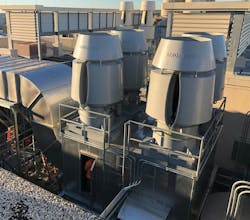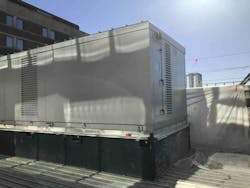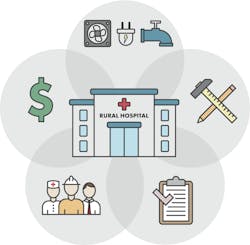MEP design considerations for rural hospitals
Rural hospitals present unique opportunities and challenges for healthcare facility operators. Oftentimes, the infrastructure and building systems have not been updated for years and require significant improvements in order to meet today’s modern medical demands. Additionally, as these smaller, more remote hospitals are acquired by larger regional and national healthcare systems, the first step by new ownership is often to update and rehabilitate the building.
But how can this be done thoughtfully, economically, and efficiently in ways that allow the engineering and facility staff to adapt to the changes? And how can the updates accurately reflect the specific needs of rural communities and the afflictions with which these areas most commonly face?
Getting Started
To understand the updates needed for a mechanical, electrical, or plumbing (MEP) system upgrade for a rural hospital, the first step is to understand the current system and configuration of the associated renovation scope. A thorough review of any existing drawings, including previous renovations, should be studied to understand the MEP systems within the proposed renovation scope.
As you examine the existing drawings, look for the original building date of construction and the age of the existing mechanical, electrical, and plumbing (MEP) infrastructure systems within the building. Then review any information available on previous renovations that have already occurred. The goal is to have a solid understanding of the existing systems and how they have been modified over the life of the building, and gain knowledge of the current system configuration within the building.
After reviewing the existing condition drawings for the proposed renovation area, connect with the owner and key facilities staff in order to discuss and understand the existing issues or problems the staff deals with on a regular basis. This discussion with facilities staff can inform architects and engineers on design decisions for any renovation project and help them understand existing problems and plan to address them during renovations and system modifications.
Here are a few questions to ask the end user:
- Are certain systems in immediate need of replacement?
- Can the owner prioritize them?
- What challenges keep them up at night?
- How reliable are the utilities? What reliability are they wanting to gain?
The next step is to find out who performs the maintenance on the systems or what local businesses provide the support for the MEP systems. It may be an uncomfortable question, but it is important to find out the capabilities of the staff. Rural hospitals and healthcare systems may not have the capabilities to handle large complex systems, so their ability to maintain and operate systems in order to perform at their most efficient point is critical to good performance and longevity.
Another pertinent question to answer is finding out the hospital’s goals for the project. Are their decisions based on cost/budget, timeline, priority of care, certification, or updated codes? Is there a long-term vision for an increase in census or an expansion or program change for the facility?
Again, these are things that may inform decisions and guidance from the design team. The project budget may not meet the goals of the owner, so the design team needs to be able to guide the owner through a decision-making process to have the project scope match the budget. If the schedule is critical, phasing the project may be necessary. Early design packages or specifications for longer-lead materials may be warranted. The project may be in a critical care area or critical function of the hospital, so downtime of building systems may need to be considered and a discussion about the necessity of temporary utilities reviewed.
Certification by local Authorities Having Jurisdiction (AHJ’s) or other entities may require discussions between the owner and those groups as to what is required and what can be reasonably achieved based on schedule or budget.
If existing condition drawings are not available or do not appear to be complete with the most current layout, a detailed field survey will be required. Even if existing condition drawings are available, a detailed field survey of the area of renovation is recommended to:
- Confirm the existing condition drawings are accurate.
- Document any change that may not be captured on as-built drawings and could potentially affect the design of the renovation.
Being able to verify the existing project conditions, identify new conditions that are not shown in the existing conditions drawings or may have been undocumented, and note disconnection and reconnection points to areas adjacent to the renovation will be important in providing high-quality project documents. Poor design or scope gaps found during construction can lead to change orders and project cost increases, which may be difficult for a rural entity to absorb given their often-limited budgets for projects or upgrades.
If the project involves centralized heating or cooling equipment replacement, an understanding of the thermal demands of the space is critical. This can be completed through a variety of methods.
- The first and most reliable method is a review of trend data, if available. At least three years of data is preferred to account for variations in seasonal temperature extremes. Chilled water trend data can be plotted against outdoor air enthalpy (or wet bulb temperature if enthalpy is unavailable). For heating, plot data versus the dry bulb temperature. This plot should result in tight grouping of points along a curve. If this is the case, the trend data is likely reliable and can be utilized to estimate maximum and minimum loads.
- If trend data is not available, an accounting for all equipment sizes via as-built document review or field investigation can be completed. This will provide the maximum potential load on the building. Depending on the size and space mix in the facility, a diversity factor can be applied.
- In addition to the review of existing demand-side equipment, an understanding of supply-side equipment is important. Interviews with facility operational staff should take place to determine whether the existing equipment is able to keep up with the demands of the facility. This will determine the peak equipment size. Field observations of equipment operation on peak heating and cooling days will help align building load estimates.
- Finally, a square footage estimate of the facility and unitary load factors can be utilized as a final check.
By utilizing the strategies outlined above, both heating and cooling loads can determine and validate the sizing of a centralized thermal utility plant. Similarly, for the electrical systems, meter data for the normal and emergency power systems needs to be collected and evaluated.
Codes and Standards
As part of the review of the existing conditions within the project renovation scope, understanding the codes and standards the existing facility—or the facility’s last renovation—was designed to meet will inform necessary design decisions to bring the project scope up to current standards. Standards and requirements from any AHJs should also be reviewed to understand if there are additional requirements that need to be considered during design.
Existing facilities designed to previous codes and standards may require additional work outside of the renovation scope to upgrade and update systems to comply with current codes and standards. Depending on the age of the facility and the last renovation, this can greatly increase the cost and complexity of the renovation. Thorough code research should be done in conjunction with the review of the existing building drawings and field surveys to understand what additional scope, outside of any proposed renovation may be necessary. The potential cost and schedule impacts should then be discussed with the owner to determine if the project scope or budget needs to be adjusted accordingly.
Two important codes related to any hospital renovation are NFPA 99 and NFPA 101.
NFPA 99: Health Care Facilities Code, is an essential code to review for any healthcare design, especially as it relates to requirements for medical gas systems, grounding, and essential electrical systems.
NFPA 101: Life Safety Code, is essential for healthcare as it relates to patient safety and critical care of individuals that may not be capable of self-preservation. There are sections specifically written for existing and new healthcare occupancies.
NFPA 99 has criteria related to the “levels of care services or systems-based health care services or systems based on risk to the patients, staff, or visitors” (NFPA 99 – 2018), along with information on building MEP systems. Medical gas systems specific to healthcare facilities are covered in detail as part of this code, which is not covered in other codes or standards. The code also has specific information on security systems and emergency management, which may inform owner decision making.
NFPA 101: Life Safety Code provides requirements for occupant protection, structural integrity, protection of hazardous materials during emergencies, mitigation of physical violence against occupants, and effectiveness of the building systems. The overall goals of the code are to provide a safe environment for occupants during a fire to both those who may be directly or indirectly affected, provide life safety during emergencies, and provide reasonably safe emergency and non-emergency crowd movement.
The International Mechanical Code does require healthcare facilities, including ambulatory care facilities, to comply with ASHRAE Standard 170: Ventilation of Health Care Facilities. “The purpose of this standard is to define ventilation system design requirements that provide environmental control for comfort, asepsis, and odor in health care facilities” (ASHRAE 170 – 2017).
HVAC systems must comply with the requirements outlined in this standard, which covers equipment and distribution of conditioned air throughout a building. Specifics related to filtration, air change rates, pressurization, and temperature and humidity requirements are all covered in the standard.
Two standards of note that are not referenced in building codes are the Facilities Guidelines Institute Guidelines for Design and Construction of Hospitals (FGI) and Guidelines for Design and Construction of Outpatient Facilities. The guidelines for hospitals are typical for facilities where patients will be in the facility for more than 24 hours. The outpatient facilities guidelines are geared toward ambulatory care centers or other facilities where a patient’s stay will be less than 24 hours. Although these are not codes, they provide information for design that should be considered as part of any healthcare project.
Equipment Sizing
Selecting equipment is a critical part of a successful MEP design project. Some of the factors that dictate equipment selection are driven by code. First and foremost, all selections must meet any applicable design and construction codes. For example, state energy code or ASHRAE 90.1 will define minimum efficiency requirements for most major equipment in hospital settings. Depending on the equipment, local and state health departments may also dictate redundancy requirements.
Some equipment selection decisions leave the design team with more latitude. The number of pieces of a certain type of equipment or a system configuration are decisions that should be made closely between the design team and owner.
Using the tools previously described in this article to estimate a facility’s chilled water load, a chiller system to serve the demand will need to be selected. The first decision to be made is the type of system to use. Factors such as first cost, operating cost (efficiency), maintenance, and flexibility should all be considered during the decision-making process. For example, a water-cooled system may offer the most efficient chiller plant but highest first cost, while an air-cooled plant could have low first cost and ease of operations but have a higher operating cost.
Once system type is selected, it’s time to determine how many and what size of equipment to use. For example, a facility that has a 500-ton peak chilled water load could easily be served by a single 500-ton machine, but can that unit also turndown to serve the minimum demand without excessive cycling? Additionally, to meet N+1 redundancy would require the installation of a 1,000-ton chiller plant. Consideration of two machines at 50% size or three at 33% may serve the facility better and also result in a lower first cost.
Lastly, there are many hard-to-quantify issues that should be considered:
- How supportive or close are the local manufacturers’ service teams? If one manufacturer has a shop 10 miles away and another is 100 miles away, it’s worth considering the manufacturer with local support.
- Does this facility have existing systems or a sister facility with similar systems? If there is consistency in the maintenance staff, maintaining fewer types or brands of equipment will ease the learning curve for staff and minimize the number of spare parts to maintain the equipment.
Budgets and Financials
Rural hospitals typically have both limited budgets and limited opportunities to renovate or upgrade MEP systems compared to hospitals in metropolitan areas. To develop realistic construction budgets for upgraded MEP systems—and not be surprised on bid day—hospitals should consider the age of the facility, the available labor force in a rural community, and the staffing in their own maintenance departments.
The facility manager or design team should consider the following cost variables:
- When was the facility built? When was the last time the system was renovated?
- What NFPA, Mechanical Code, Electrical Code, or NEC version was in place when the facility was built and/or last renovated?
- What does today’s code require? For example, ASHRAE 170 requires for central cooling systems greater than 400 tons peak cooling load that the number and arrangement of cooling sources, and essential accessories shall be sufficient to support the owner’s facility operation plan upon a breakdown or routine maintenance.
Another variable that should be considered when developing budgets for MEP upgrades is the associated skilled construction labor pool near the rural hospital. Replacing a generator or chiller while the healthcare facility is operational requires a level of expertise that is typically not available in a rural setting. As such, the budgets should include an increased cost in mobilization, travel, and lodging in order to get experienced contractors to participate on bid day.
Another item to consider in creating a budget for MEP upgrades is the level of expertise in the maintenance departments. Rural hospital maintenance staff may only have the capability to handle small maintenance activities, while larger system repairs are outside of their capabilities. In these situations, owners may have maintenance contracts with outside companies to deal with larger problems.
In these cases, meeting minimum code required for system redundancy is not an option. Half of the facility could be without heat or conditioned air for weeks if an outside service technician cannot be on site to repair the equipment or get the necessary parts. Sizing a number of generators, chillers, boilers, or fans in an air handling unit should be weighed with an understanding of how long it may take to repair these systems.
Conclusion
All projects present unique challenges and opportunities, none more so than MEP design for rural hospitals. As many of these smaller facilities are being purchased by large hospital systems, new ownership must take time to understand the intricacies of these facilities and hire experienced engineers who are sensitive to these complexities.
The best place to start is with a thorough understanding of the existing facility. During the design process, codes and standards are critical to informed planning. Additionally, MEP equipment sizing will be much different for rural hospitals than for large metropolitan centers. Lastly, keeping budget, staffing, and the long-term vision and goals in mind is key to a successful MEP infrastructure upgrade at any rural hospital.
ABOUT THE AUTHORS
Beth Crutchfield, PE, LEED AP, is Partner and South Carolina Electrical Division Manager with RMF Engineering. A licensed professional engineer with 27+ years experience, Crutchfield is a certified U.S. Green Building Council LEED Accredited Professional (LEED AP), and is an active member of The Society of Women Engineers.
Jonathan Eveleth, PE, CEM, LEEP AP, is Partner and North Carolina Infrastructure Project Manager with RMF Engineering. He is a licensed professional engineer with 13+ years of experience in the design and construction of chiller and boiler plants.


